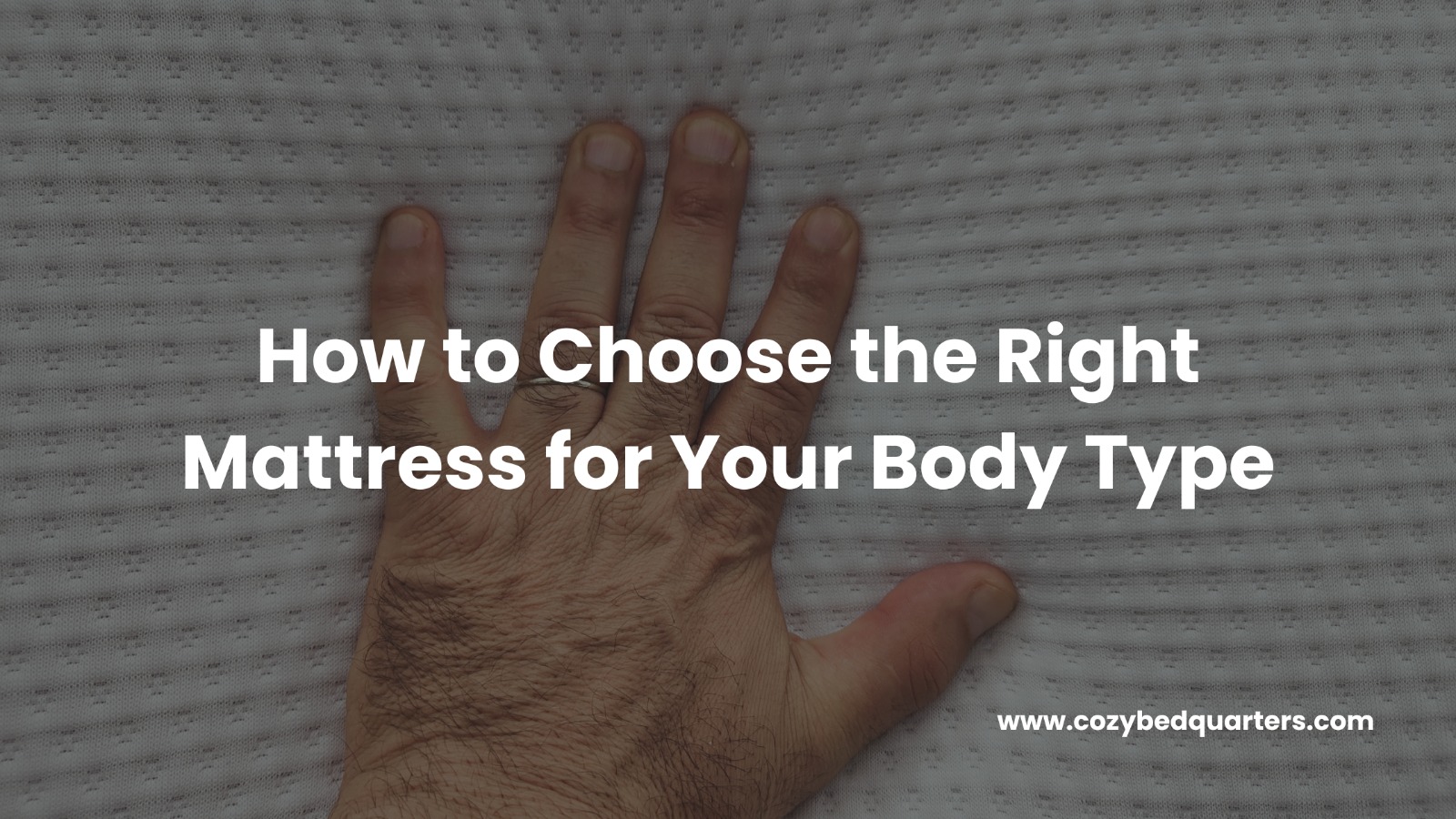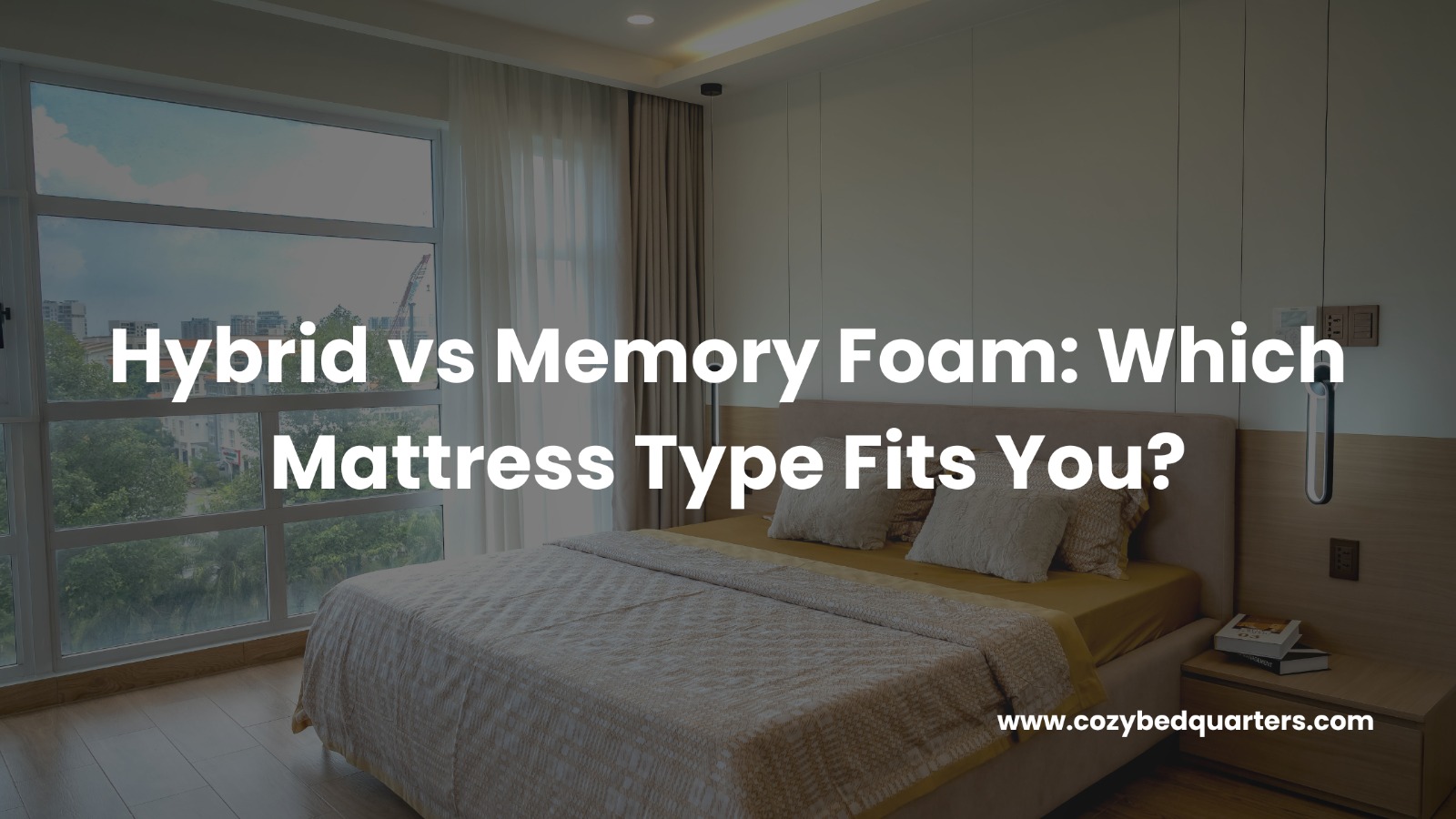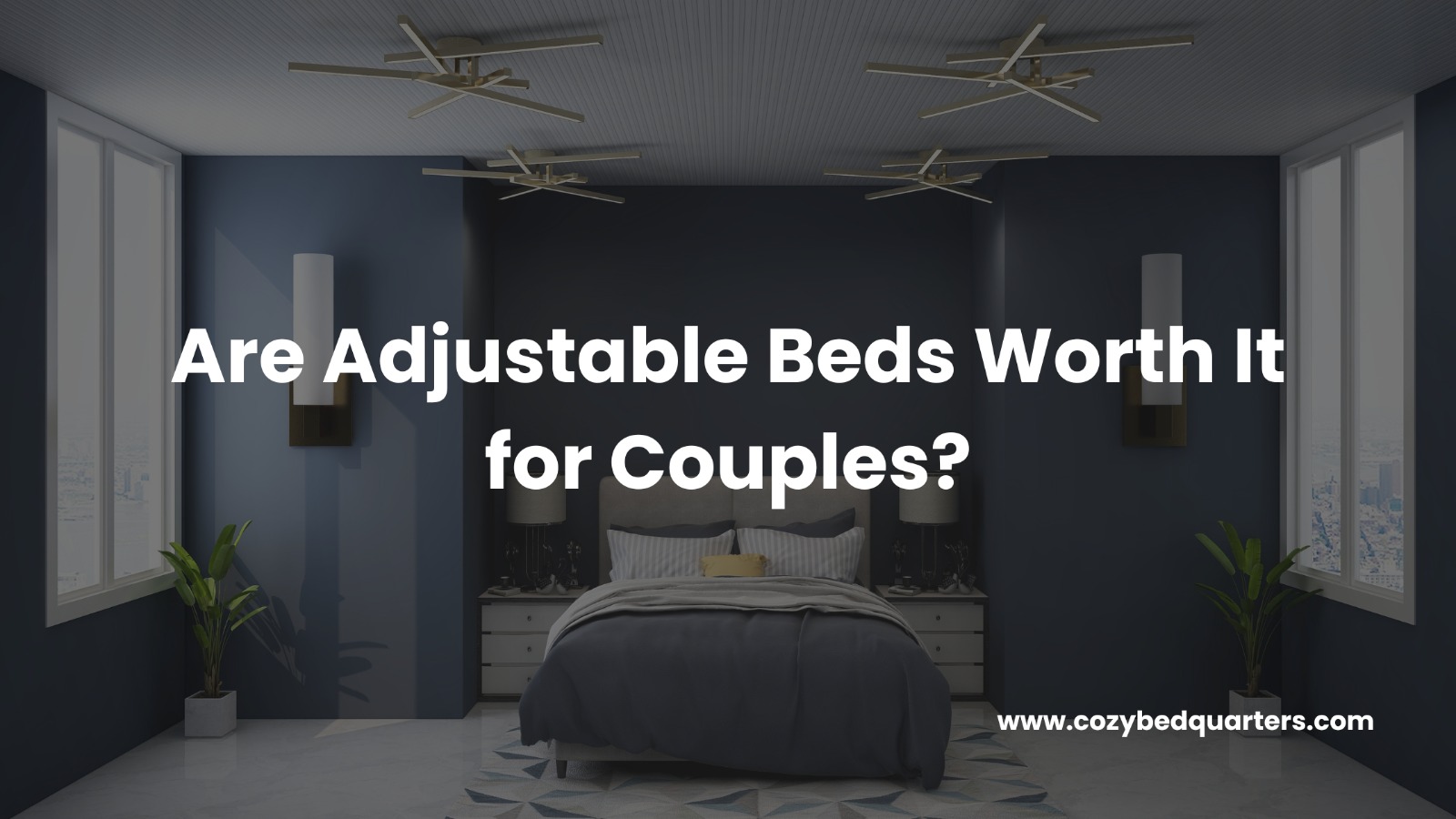Choosing the Perfect Mattress for Your Body Type
Buying a mattress may seem simple, but your comfort depends on more than just softness or size. Every body type requires specific support, firmness, and materials to maintain proper alignment and rest quality. The wrong mattress can cause neck pain, backaches, or restless nights. The right one feels effortless, cradling your curves, supporting your spine, and helping you wake refreshed.
At Cozy Bed Quarters, we guide sleepers through this decision using research-backed insights and real comfort testing. Whether you’re lightweight, average, or heavier, understanding your body’s needs ensures a healthy, rejuvenating sleep every night.
Why Your Body Type Matters When Choosing a Mattress
Everybody distributes weight differently. That’s why two people can lie on the same mattress and experience opposite comfort levels. Someone lighter might feel too firm a surface, while a heavier person might sink too deeply.
When your mattress matches your body type, it helps:
- Maintain neutral spine alignment through the night
- Prevent pressure buildup on shoulders, hips, and joints
- Improve circulation for better rest
- Extend the life of your mattress with even wear
Cozy Bed Quarters understands that comfort isn’t one-size-fits-all. Your body type defines your sleep experience, and choosing accordingly creates a long-term difference in your health and energy.
How to Choose the Right Mattress for My Body Type
When selecting a mattress, your body weight, sleeping style, and personal comfort preferences should work together. Let’s break it down for each body category:
1. Lightweight Sleepers (Below 130 lbs)
If you’re on the lighter side, softer or medium-soft mattresses allow your body to sink just enough for proper contouring. Firm mattresses may create pressure on the hips or shoulders.
Best picks:
- Soft memory foam: Conforms to delicate curves and offers a cushioned feel.
- Plush hybrid mattresses: Balance support with comfort layers.
- Latex foam with medium softness: Provides bounce without feeling hard.
Pro Tip: Check for mattresses with responsive foam layers. Cozy Bed Quarters’ soft-touch memory foam models support lighter frames without making you feel “stuck.”
2. Average Weight Sleepers (130–230 lbs)
For medium body types, a medium-firm feel usually delivers the right combination of comfort and structure. You’ll want a surface that supports your spine but still relieves pressure points.
Recommended options:
- Hybrid mattresses: Provide adaptive comfort for all sleeping positions.
- Memory foam with zoned support: Adjusts to your shoulders and hips individually.
- Latex models: Add a natural, breathable layer that prevents overheating.
At Cozy Bed Quarters, our medium-firm hybrid designs cater to this range perfectly, combining support coils and foam layers to maintain balance all night long.
3. Heavyweight Sleepers (Above 230 lbs)
Heavier sleepers often need firmer support to avoid excessive sinking, which can cause spine misalignment and back pain. Look for durable, high-density materials and reinforced edges for stability.
Best choices:
- Firm hybrid mattresses: Provide deep support with responsive comfort layers.
- High-density memory foam: Holds shape and resists sagging.
- Natural latex mattresses: Offer firm yet buoyant support that lasts for years.
Cozy Bed Quarters includes options with thicker profiles (12–14 inches) to provide structure and durability without compromising comfort.
How Sleeping Position Affects Mattress Choice
Besides your body type, your sleeping position greatly impacts which mattress feels right. Let’s understand what suits each style.
Side Sleepers
Side sleepers often experience pressure on their shoulders and hips. A soft or medium-soft mattress cushions these points while supporting the spine’s natural curve.
Ideal materials: Memory foam, plush hybrid, or soft latex.
Best firmness: Medium-soft to medium.
Back Sleepers
Back sleepers need to keep their spine neutral. Too soft, and the hips sink; too firm, and the lower back arches. A medium-firm mattress supports natural posture.
Ideal materials: Hybrid, firm foam, or latex.
Best firmness: Medium-firm.
Stomach Sleepers
Sleeping on your stomach demands firm support to prevent sinking around the midsection. Without it, lower back pain becomes inevitable.
Ideal materials: Firm hybrid or innerspring mattress.
Best firmness: Firm.
At Cozy Bed Quarters, you can find mattresses crafted to align with every sleeping style, ensuring comfort whether you rest on your side, back, or stomach.
Is a Firm or Soft Mattress Better for Back Pain?
This is one of the most common questions people ask: “Is a firm or soft mattress better for back pain?” The answer depends on body type and sleeping habits.
- Firm mattresses are suitable for heavier individuals or stomach sleepers who need sturdy support to avoid lower back sinking.
- Soft mattresses are better for lighter sleepers or side sleepers who need cushioning around joints.
- Medium-firm mattresses suit most people by keeping the spine in a healthy position while still feeling comfortable.
If you frequently wake up with stiffness or pain, you might be sleeping on the wrong firmness level. Cozy Bed Quarters offers orthopedic and ergonomic options designed for balanced support, pressure relief, and comfort longevity.
Understanding Mattress Materials and How They Affect Comfort
Different materials create different sensations and durability levels. Here’s a quick guide:
Memory Foam
Contours deeply, providing personalized pressure relief. Excellent for those with joint pain or side-sleeping habits.
Latex Foam
Bouncy, breathable, and naturally hypoallergenic. Ideal for hot sleepers and those seeking eco-friendly comfort.
Innerspring
Provides traditional support with firm bounce and great airflow. Perfect for stomach and back sleepers.
Hybrid
Blends foam comfort with spring stability. Best for combination sleepers who need adaptability.
Cozy Bed Quarters’ hybrid range uses multiple comfort zones, gel-infused layers, and edge-to-edge support to enhance every sleeper’s experience.
Key Features to Consider Beyond Firmness
While firmness and materials matter most, several other features affect your sleep experience:
1. Mattress Thickness
Thicker models (12–14 inches) usually last longer and offer better deep compression support.
2. Cooling Technology
If you sleep hot, look for mattresses with gel-infused foams, breathable covers, or open-cell construction, features that Cozy Bed Quarters integrates across its premium lines.
3. Motion Isolation
Sharing a bed? Memory foam or hybrid mattresses reduce motion transfer, ensuring one partner’s movement doesn’t wake the other.
4. Edge Support
For those who sit or sleep near the sides, reinforced edges prevent sagging and extend mattress life.
5. Certifications and Safety
Always check for CertiPUR-US or OEKO-TEX certified materials for health-safe, non-toxic sleep surfaces, standards followed by Cozy Bed Quarters for every model.
Quick Mattress Matching Guide
Here’s a summary table to help you decide:
| Body Type | Sleep Position | Firmness Level | Mattress Type | Benefit |
| Lightweight | Side | Soft–Medium | Memory Foam / Hybrid | Pressure Relief |
| Average | Back | Medium–Firm | Hybrid / Latex | Balanced Support |
| Heavyweight | Stomach | Firm | Firm Hybrid / Innerspring | Spine Alignment |
This guide simplifies your buying process by connecting physical needs with sleep comfort.
Additional Tips for Selecting the Right Mattress
- Try before buying: Whenever possible, test mattresses in-store or rely on online brands offering sleep trials.
- Consider bed frame compatibility: Your base affects support; ensure it suits the mattress type.
- Think about longevity: High-quality materials may cost more initially but save money over time.
- Review your sleeping environment: Temperature, humidity, and airflow can influence comfort.
- Avoid trends: Choose what feels right for your body, not just what’s popular.
Cozy Bed Quarters’ specialists can guide you through personalized consultations, helping you identify what works best for your comfort profile.
Mattress Care and Maintenance
To keep your new mattress performing its best:
- Rotate every 3–6 months to prevent dips.
- Use a waterproof protector for hygiene and longevity.
- Keep it well-ventilated to avoid moisture buildup.
- Avoid bending or dragging to protect internal layers.
With proper care, your Cozy Bed Quarters mattress can maintain its comfort and structure for 8–10 years or more.
Busting Common Mattress Myths
Myth 1: Firm mattresses are always better.
A firmer mattress isn’t automatically more supportive; it must match your weight and sleep style.
Myth 2: All memory foam traps heat.
Modern cooling foams and breathable covers now make memory foam comfortable even for hot sleepers.
Myth 3: Mattresses don’t affect posture.
Your mattress has a direct impact on spinal health and long-term posture quality.
Myth 4: Expensive means perfect.
The best mattress isn’t always the most expensive; it’s the one that fits you. Cozy Bed Quarters focuses on value-driven comfort, not gimmicks.
Why Investing in the Right Mattress Pays Off
A mattress isn’t just furniture; it’s a wellness investment. Quality sleep improves immunity, focus, mood, and productivity. Poor sleep, on the other hand, contributes to stress, fatigue, and chronic pain.
The right mattress from Cozy Bed Quarters supports your spine, reduces discomfort, and improves rest quality, leading to a noticeable difference in how you feel every morning.
Think of it this way: You spend nearly one-third of your life in bed. Shouldn’t that time feel effortless and restorative?
Sleep Smarter with Cozy Bed Quarters
Choosing the perfect mattress for your body type isn’t guesswork; it’s about understanding your body, habits, and comfort level. From lightweight sleepers to those who require firmer support, each person deserves a mattress that suits their unique sleeping needs.
Cozy Bed Quarters simplifies this journey by combining science-backed design with comfort-driven craftsmanship. Whether you prefer plush softness, firm stability, or balanced hybrids, every product is built for better sleep and long-lasting satisfaction.
Your next restful night could be one mattress away.
Explore premium collections at Cozy Bed Quarters. Experience personalized comfort that supports your body, every night.










